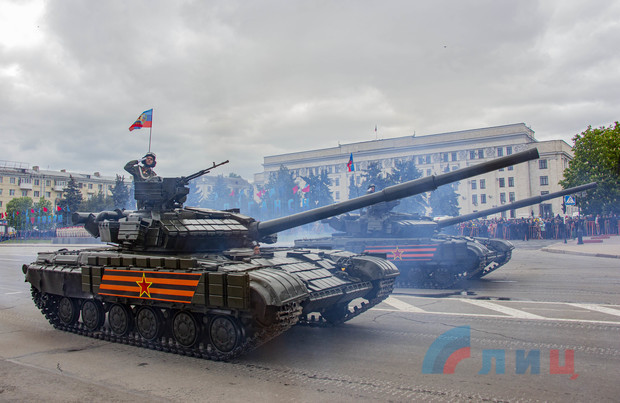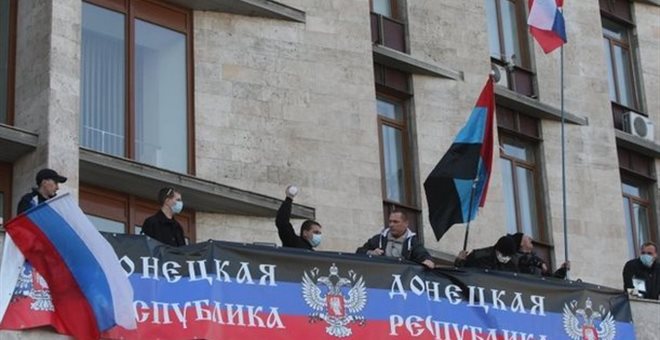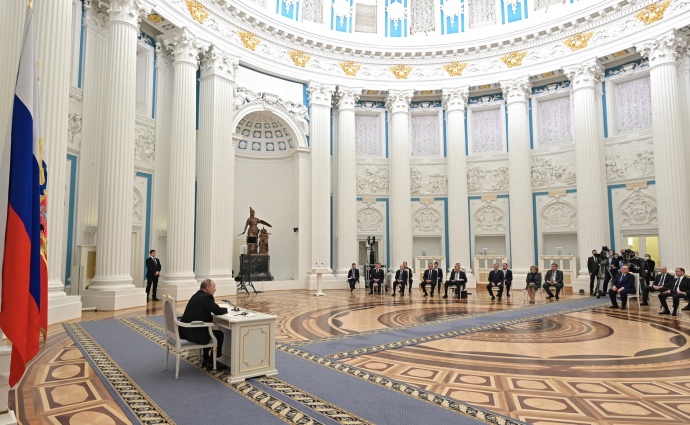In late April, Berlin-based project Civicmonitoring.org issued the annual report “Towards de-facto annexation? Current developments in the ‘People’s Republics’ of eastern Ukraine 2020/2021“ authored by Nikolaus von Twickel. The paper explores the events, changes, and tendencies in politics, economy, security in the Russian-controlled part of Ukraine’s Luhansk and Donetsk oblasts over the past year and the first three months of 2021.
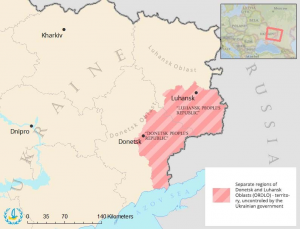
In the online presentation of the report that took place on 8 June, its author, Nikolaus von Twickel, pointed out that,
“This is the first time we actually decided to put a thematic headline on our annual report since that has been coming out every year since 2016. I would say that de facto annexation is actually nothing brand new,.. this development has been ongoing for the last three or four years especially since 2017.”
However, according to him, the so-called people’s republics have been turning towards Russia more and more in all aspects of life.
The Russian-occupied areas are referred to as ORDLO or the Certain Areas of Donetsk And Luhansk Oblasts by Ukraine and as non-government-controlled territories in OSCE reports. Meanwhile, the occupation authorities had proclaimed so-called Donetsk and Luhansk people’s republics (DNR and LNR, or collectively, LDNR), unrecognized pseudo-states meant to create the illusion that the developments had something to do with the self-determination of locals rather than with the Russian occupation. The step was partly successful, as Western media often refer to the Russian occupation administrations as separatists.
Here are several key findings of the report.
- In 2020, the COVID-19 pandemic hit the non-government-controlled territories hard, causing “what is probably the severest downturn since 2014“ with serious labor unrest, growing wage arrears, and the exodus of skilled workers. However, it didn’t shake the power of the DNR and LNR rulers thanks to a massive security apparatus that would crack down any dissent in the area.
- With coal production being one of the major economic sectors in non-government-controlled territories, the demand for coal dropped, prompting “people’s republics” to start closing unprofitable mines. Meanwhile, layoffs and wage arrears “made an already bad situation worse.”

- The dismissal of Vladislav Surkov, the Kremlin’s curator for the Donbas “republics” and appointing his rival Dmitry Kozak to his position had almost no noticeable effect. Surkov is believed to have been the major architect who had designed the “People’s Republics” in 2014 and was the Russian official to oversee the politics of the “republics” up until the last winter, while Kozak was the Russian government’s curator for Donbas economy policies.
- The ceasefire brokered on 22 July 2020 significantly improved security along the 427-kilometer-long frontline officially known as the contact line, yet the overall situation “remained volatile as some 80,000 troops remain stationed on both sides of the Contact Line,” while Russia’s massive buildup of its troops along the northeastern border of Ukraine and in Crimea in spring 2021 “reminded the world that military escalation is also possible.”

- As in all previous years, the human rights situation remained dire with both critics and supporters of the regime risking detention and torture while having nearly non-existent access to justice. More details became known about the infamous detention center Izolyatsia in Donetsk, more critics and supporters of the regime “vanished and were seemingly arrested by the notorious State Security ‘Ministry’,” the report reads. The Freedom House’s Freedom in the World Report of March 2021 awarded the “people’s republics” just 4 out of 100 points, one less than the year before, and ranked them just above North Korea and Turkmenistan.
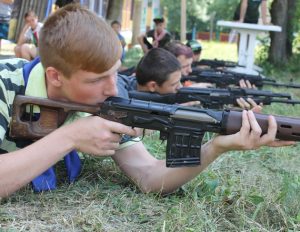
- The report mentions that Ukrainian prosecutors and human rights activists pointed to the “growing indoctrination and militarization of children“ and in February 2021 the country’s Prosecutor General opened criminal proceedings against DNR-run military and patriotic clubs for the youth that prepare minors for combat.
- The environmental crisis posed by the policy of flooding the shutdown coal mines instead of proper decommissioning also worsened in 2020. Closed mines were flooded after the pumping stopped, meanwhile, falling groundwater levels threaten rivers and lakes. To make matters worse, wastewater from flooded mines brings acids and heavy metals into the environment.
Meanwhile, Russia significantly reduced its official “humanitarian aid” to LDNR. Unlike past years when Russia sent twelve aid convoys to Donetsk and Luhansk, the year 2020 saw only three of those. According to the official version, the last of those that arrived on 17 December, delivered medical equipment bringing only one-third of previous payloads.
“Integration with Russia”
Like previously, de-facto authorities of Luhansk and Donetsk kept on imposing the policies of “integration with Russia” which amount to “Russification of more and more aspects of public life while paying little more than lip service to the Minsk Agreement, which stipulates reintegration with Ukraine.”
The issuing of Russian passports to the residents of ORDLO that started back in 2019 continued in 2020 and by the end of the year, “more than 400,000 inhabitants are thought to have received Russian citizenship – some 200,000 from each ‘People’s Republic’,” the report says.
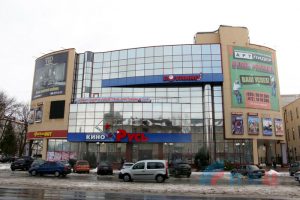
Also in 2020, both “republics” abolished Ukrainian as one of the “state languages.” The status was purely formal as Ukrainian was hardly used in media and by the de-facto authorities, so it was a rather symbolic step of giving up “another vestige of being part of Ukraine.”
On 18 March, Russian President Vladimir Putin complained that the USSR in the 1920s and Russia in the early 1990s had given up “colossal territories” and “geopolitical space.” “DNR head” Denis Pushilin, speaking the same day in Crimea, said that the Donbas was on track to rejoin Russia.
“However, this irredentist rhetoric was not matched by concrete steps,” the report reads.
COVID-19
The coronavirus pandemic posed massive challenges to LDNR as the population of the non-government-controlled territories is “massively overaged following the large-scale exodus of working-age inhabitants.” Officially, there are more than one million pensioners in the “republics” or more than half of the local population. Meanwhile, the health sector and “an ailing industrial economy make an adequate response all the more difficult.”

The DNR reported 27,807 COVID-19 cases with 2,178 deaths from the virus as of 21 March 2021. The report says that this number translates to 1,980 deaths per 1 million inhabitants, which is a higher cumulative death rate than the hardest-hit EU countries.
“The figures that were released by Donetsk are quite truthful… I’m not saying that the official infection levels are as high as in real life but that is of course not because they’re lying but just because they don’t have enough tests,” said Nikolaus von Twickel at the presentation of his report.
Meanwhile, according to the report, the COVID-19-related figures, released by the de-facto authorities of Luhansk “looked like plain fiction” with only 3,489 cases and 304 deaths reported by 21 March 2021. As per the report, this translates to 434 deaths per 1 million inhabitants which is only a fraction of the figures in neighboring Donetsk.
The occupation authorities anchor their biggest hope to overcome the pandemic on Russia’s “Sputnik V” vaccine.
Ceasefire
The report points that 2020 was marked by “what was probably the most significant fall in violence since the conflict began in 2014” after the Trilateral Contact Group (Ukraine-Russia-OSCE) which negotiates peace for the east of Ukraine with Russians under the OSCE mediation brokered another ceasefire in July 2020.
“The number of Ukrainian soldiers killed during the year 2020 was consequently much lower than in previous years. 50 service people were killed and another 339 injured, according to Defence Ministry figures… Thus, military losses almost halved compared to 2019, when the number of killed soldiers was just under 100,” the report reads.
While “LNR” didn’t provide any figures of military casualties, “DNR ombudswoman” Daria Morozova stated that 39 fighters were killed in January-November 2020, which, according to her, was less than any year since 2014, for example, 149 were killed in 2019, according to her.
The report, however, says that the number of civilian casualties improved not much, referring to the data by the OSCE’s Special Monitoring Mission (SMM). The mission’s monitors recorded 23 civilian deaths and 105 injuries throughout 2020, which was only “four more deaths and 23 injuries less than in 2019.”
Conclusion
The report concludes that the longer Russia is going to “sustain the ‘people’s republics’ as bargaining chips and propaganda tools, the lesser the hopes of Ukraine and her allies to restore the country’s territorial integrity.”
The solution for the conflict now differs strongly on each side of the contact line, according to a February 2021 survey by Kyiv Sociology Institute and Russian pollster Levada Marketing Research, which found that more than half of respondents from government-controlled areas want the non-controlled areas to return without any autonomy, while over half of those living in ORDLO said that they are for joining Russia with or without an autonomous status.
“Moscow continues to cement the status quo. Relentless anti-Ukrainian propaganda, a tight police state and military and political indoctrination especially in schools and universities are making it harder every year to imagine a return of Donetsk and Luhansk to Ukraine,” the report reads.
Read the full text of the report on civicmonitoring.org.
Read more:
- Four Ukrainian soldiers killed in Donbas as Russia continues troop buildup and escalates propaganda
- Official data prove Russia funnelled trainloads of ammo and fuel to occupied Donbas in early 2015
- Three warders who tortured prisoners in occupied Donbas “concentration camp” ID’d as Russian citizens
- Ukrainian court sentences Russian proxy “republic” ex-leaders to life imprisonment in absentia for 2014 airplane downing
- Donbas negotiations in deadlock again as Russia demands local elections (again)
- Ukraine remains committed to ceasefire in Donbas despite flareup taking life of one soldier (2020)
- Wave of strikes sweeps over occupied Donbas as coal mines are shut down (2020)
- Russian-occupied enclaves risk becoming COVID-19 time bombs for Ukraine (2020)
- Russia’s policies toward Ukraine remain unchanged month after Kremlin’s “gray cardinal” replaced
- Zelenskyy plans total troop withdrawal in Donbas while Russia gives no guarantees (2019)




